Showing the World: In 1908 and 1909, the Wright brothers, Orville and Wilbur Wright, demonstrated their machine to the world with cameras rolling.
A New Entertainment: The Wright Exhibition team brought the airplane to thousands through their performances. They flew a president, appeared over New York, and even made a comedy!
Legend and Legacy: As Wrights and their students receded into retirement, their achievements were often recalled in celebration of aviation’s dramatic development.
The Wright brothers’ historic first public flights introduced a skeptical public to controlled, powered flight. The flights also mark the first time the Wrights were filmed. These films serve today as they did then—as proof that the Wrights truly achieved all they had claimed. Wilbur flew in public first, at Le Mans, France, in May of 1908. Orville’s flights at Fort Myer in 1908 and 1909 were the Wrights’ debut in America. He continued to fly in Europe in 1909. These flight were all caught on film.
Almost as soon as aviation was born, it became a form of entertainment. Crowds filled racetracks to see their favorites performing death-defying stunts. Soon they were filling movie houses as the flying acts made it to the silver screen. Interestingly enough, in a number of films, instead of a knight in shining armor, heroines fly to the rescue in a Wright Model B.
One of the enduring images of the early aviators, with the Wrights themselves as a notable exception, is of the daredevil tempting fate in his flying machine. This role seems to have developed spontaneously as the first aviators developed quickly as both pilots and showmen. Indeed, the most prevalent use of the airplane in its early days was for demonstration and entertainment, and the pilots eagerly thrilled the crowds with their seemingly dangerous stunts.
The truth is that many of the pilots were cautious, dedicated professionals who continued in long careers in aviation, or retired early, weary of the show circuit. Either way, the romantic figure of the dashing and daring flyer remained, and was enhanced by both documentary and fictional films. Newsreels depicted heroic records being shattered, races being won, and grisly, tragic crashes. Studio films offered much the same, with a finely crafted romantic subplot for extra drama.
Despite the exaggerations and skewed representations of flying in many of these early films, they helped to introduce the airplane to the public and inspire the continued development of aviation beyond entertainment. Motion pictures were distributed far more widely and reached more people than the actual exhibition flights ever could. The long standing relationship between the movies and flying was set.
As aviation evolved and grew in importance, the Wrights’ role as the inventors of the airplane was increasingly celebrated and commemorated. By the time of Orville’s retirement as a pilot in 1918, the early days of flight were over. The first airplanes and pilots had become reminders of a bygone era. As the early days of flight receded into history, they were memorialized with increasingly sophisticated uses of film: documentary, newsreel, and up to television.
Special Effects? Not Quite!
A popular early melodramatic serial called “The Perils of Pauline” employed a very creative use of aviation footage to tell its story. The heroine, Pauline, is forever being brought to the brink of death by the scheming villain, Koerner. In one epiosde, he tries to get rid of her by having her perish in an airplane crash. In the sequence shown below, though, seven different machines are used to play the role of one airplane!
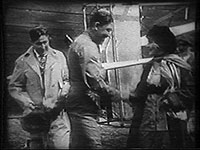
The Villain takes Pauline to meet the Aviator, in hope that he’ll take her for a ride. They are standing by the tail of a Wright Model B.
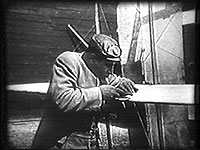
When the aviator is out, the Villain sabotages the Wright B, placing a wire to the elevator.
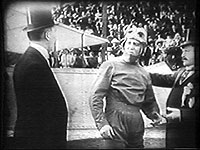
When the aviator is later forced to fly before Pauline arrives, his airplane now has a boat-like fuselage in front – no longer a Wright B.
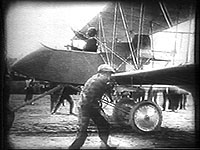
The doomed Aviator takes off, now in a French pusher plane.
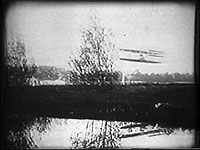
When he is shown in flight the first time he’s back in a Wright machine – this time a Model A.
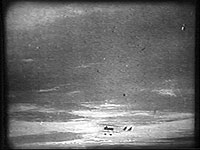
Now flying the opposite direction, and at sunset, he appears to be in yet another French pusher plane.
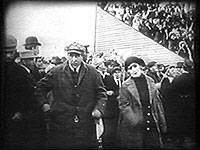
Pauline has missed her chance for a ride, and the Villain has been foiled again!
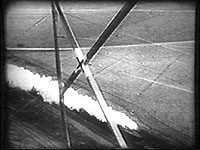
Now we see the Aviator’s point of view, from an unidentified airplane flying over a train.
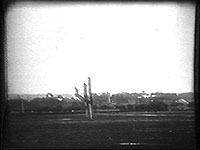
Finally, the hapless Aviator crashes as the result of the sabotage, but now he’s in a Curtiss Jenny.
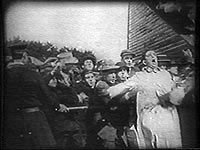
The Hero arrives, sees the crash, and fears for Pauline’s life, not knowing she never went up in the plane.
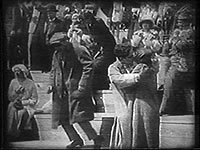
Pauline and the Hero are soon reunited, as the Villain skulks away.
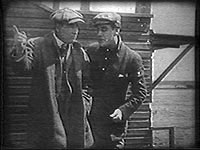
After Pauline and the Hero march off together in safety, the Villain & his henchman plot revenge.
